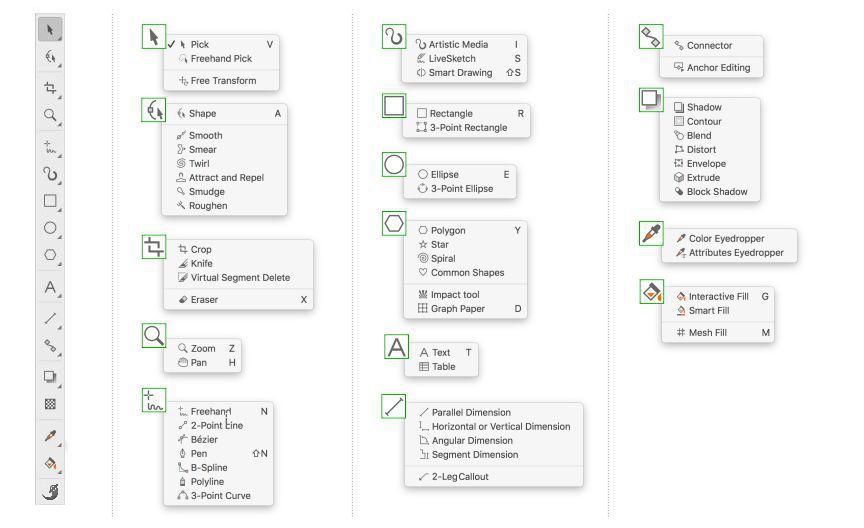Introduction
In the intricate realm of graphic design, CorelDRAW stands as a powerhouse, offering designers a rich canvas for creating visually captivating and well-organized layouts. Understanding how to select, move, and navigate table components is crucial for achieving precision and efficiency in handling complex data and designs. This extensive guide delves into the intricacies of these actions within CorelDRAW, unraveling functionalities, customization options, and the pivotal role they play in elevating your design projects.
Section 1: Grasping the Foundation of Table Components
1.1 Introduction to Table Components
Before delving into specifics, it’s imperative to understand the fundamental components of a table. From cells and rows to headers and footers, each element plays a unique role in creating a cohesive and structured table design.
1.2 Importance of Efficient Navigation
Explore the significance of efficient navigation within tables. Navigating seamlessly through components ensures that designers can work with speed and precision, making adjustments and modifications effortlessly.
Section 2: Accessing Navigation Tools in CorelDRAW
2.1 Locating Navigation Tools
Dive into the CorelDRAW interface to locate the tools for selecting, moving, and navigating table components. Understand where to find options for adjusting, customizing, and managing components based on your design preferences and project specifications.
2.2 Overview of Navigation Tools Panel
Explore the Navigation Tools Panel and its array of options. Gain insights into the different parameters you can tweak to efficiently navigate through table components, from basic selection to advanced customization.
Section 3: Basic Techniques for Selecting Table Components
3.1 Selecting Single Cells and Rows
Master the basic techniques for selecting individual cells and rows within a table. Learn how to highlight specific components for targeted modifications, ensuring precision in your design adjustments.
3.2 Selecting Multiple Cells and Rows
Explore techniques for selecting multiple cells and rows simultaneously. Understand how to use selection tools to encompass various components, streamlining the process of making consistent changes across the table.
Section 4: Advanced Customization Options for Selection
4.1 Customizing Selection Styles
Delve into advanced customization options for selection styles. Learn how to adjust the appearance of selected components, making them easily distinguishable and aiding in efficient design navigation.
4.2 Applying Quick Selection Techniques
Explore quick selection techniques for enhanced workflow. Understand how to use keyboard shortcuts and mouse gestures to expedite the selection process, saving valuable time during intricate design tasks.
Section 5: Techniques for Moving Table Components
5.1 Moving Single Cells and Rows
Master the art of moving individual cells and rows within a table. Learn how to precisely reposition components, ensuring that the layout remains well-organized and visually appealing.
5.2 Moving Multiple Cells and Rows
Explore techniques for moving multiple cells and rows simultaneously. Understand how to maintain the relative positioning of selected components, preserving the structure of the table during complex design adjustments.
Section 6: Customizing Movement Styles and Preferences
6.1 Fine-Tuning Movement Controls
Master precision controls for fine-tuning movement. Explore customization options that enable designers to tweak the position of components with utmost accuracy, ensuring that every adjustment aligns perfectly with the intended design layout.
6.2 Setting Preferences for Snap and Alignment Options
Enhance movement precision with preferences for snap and alignment options. Learn how to enable features that automatically align components to predefined guidelines or snap them into place, optimizing the design process for efficiency.
Section 7: Techniques for Navigating Within Large Tables
7.1 Using Navigation Panes for Large Tables
Explore the use of navigation panes for efficiently navigating large tables. Learn how to utilize overview panes and zoom features to focus on specific sections, making it easier to work with extensive data sets.
7.2 Utilizing Table Hierarchies for Layered Designs
Understand how to navigate within tables with hierarchical structures. Explore the benefits of layering components within tables, providing a visual hierarchy that simplifies navigation in intricate design layouts.
Section 8: Incorporating Keyboard Shortcuts for Efficient Navigation
8.1 Efficient Navigation with Keyboard Shortcuts
Enhance your workflow with time-saving keyboard shortcuts. Explore key combinations that streamline the navigation process, allowing you to move seamlessly between components and sections of your table.
8.2 Creating and Using Custom Navigation Shortcuts
Learn how to create and use custom navigation shortcuts. Explore the benefits of assigning personalized shortcuts to frequently used navigation commands, tailoring your CorelDRAW experience to your specific design preferences.
Section 9: Troubleshooting Common Navigation Issues
9.1 Addressing Component Overlapping and Misalignment
Navigate through common challenges associated with component overlapping and misalignment. From unexpected positioning to misaligned cells, explore troubleshooting techniques to maintain control and accuracy in your table layouts.
9.2 Resolving Selection and Movement Challenges
In case of unintended consequences with selection and movement, understand how to troubleshoot and resolve issues. Learn the steps to correct any alterations made in error, ensuring that the integrity of the table layout is preserved.
Section 10: Best Practices for Table Component Navigation Mastery
10.1 Efficient Table Component Navigation Workflow Strategies
Embrace best practices for an efficient table component navigation workflow. From organizing your workspace to utilizing advanced controls, adopt principles that optimize your design process, enhancing the overall workflow.
10.2 Documentation for Navigation Conventions
Maintain documentation for navigation conventions. Explore strategies for documenting specific navigation configurations and settings, ensuring that the design history is preserved and facilitating collaboration or revisions down the line.
Section 11: Conclusion
In conclusion, mastering the selection, movement, and navigation of table components in CorelDRAW is not just about manipulating data; it’s about crafting precise and visually appealing layouts. Embrace the tools, techniques, and considerations discussed in this comprehensive guide, experiment with different navigation strategies, and elevate your design projects with newfound organization and clarity. With efficient navigation as your skillset, your creative expressions in CorelDRAW become not only visually striking but also functionally robust, setting the stage for design excellence.
